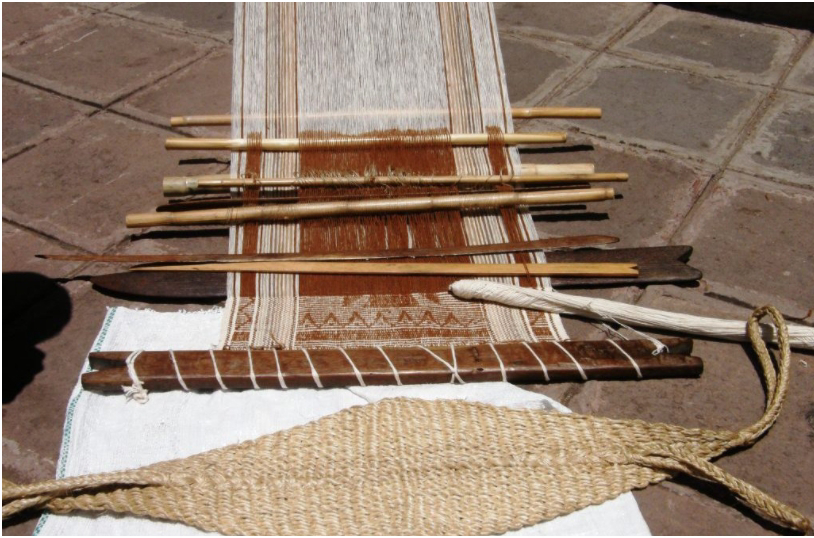BACKSTRAP LOOM:-
Backstrap loom:-
The backstrap loom is a lightweight, mobile loom made of wood and a strap that is wrapped around the back. It only needed to be attached to a tree or a post for stability and to provide tension.
THE DETAILS:
The backstrap loom has been used historically in many cultures. The Sam Noble Museum of Oklahoma describes the backstrap loom and the weaving it produces:
“Simple object for the most part, that consists of sticks, rope, and a strap that is worn around the weaver’s waist. This strap is how the backstrap loom received its name. This simple technology means that almost anyone can own a backstrap loom and that the loom can be set up almost anywhere. This mobility allows the weaver to work indoors or outside. Using the backstrap loom, a weaver can produce fabric with a plain weave. Unlike the treble loom, the backstrap loom allows the weaver to brocade designs into the fabric as it is woven. Brocade can be woven with a supplementary weft, added along with the ground weft. The elaborate brocading of huipils has given Maya weaving its distinctive character.”
An example of a Kiche Maya backstrap loom from the National Museum of the American Indian is seen in figure 1; it is composed of the loom itself with a weave in progress. This was collected or purchased from local residents in late 1925 or early 1926 by anthropologist Samuel K. Lothrop during an expedition.
An Strong explains clearly how it would be used:
“The weaver wraps a long string, called the warp thread, around both sticks. One stick is tied to the weaver’s waist. The second stick is held by the weaver’s feet or tied to a post or tree. The weight of the weaver’s body keeps the warp threads tight. Up and over, down and under, the weaver passes threads through the warp thread using a tool made from animal bone. Soon a narrow strip of fabric takes shape. Then the strips are sewn together to make clothing and blankets.”
Figure 2 shows a woman who has secured her backstrap loop to a post and is working on a weave pattern.
Backstrap weaving has been done by many different cultures across the globe, as Leslie Veirs explains in “Unraveling the Mysteries of Backstrap Weaving” (1991):
“Backstrap weaving has been done all over the world. Some of the world’s finest weaving has been done on this simple tool. This kind of loom has been used in many areas of Asia and in Scandinavia and it is still commonly used in southern Mexico, Guatemala and Peru. Until recently, Native Americans of the Zuni and Navajo tribes in Arizona used this type of loom to weave belts, sashes and pieces of narrow fabric.”
Figure 3 is a technical illustration of a backstrap loom, showing more details of how the parts of the loom interact and operate with each other.
Backstrap weaving was a popular production method for many peoples, including those of the Pre-Hispanic Americas as Daniel Hill describes in History of World Costume and Fashion (2011):
“The telar de cintura, or backstrap loom, was a simple apparatus with no rigid framework. To prepare for weaving with a backstrap loom, a set of vertical warp threads was stretched between two horizontal sticks. One stick was tied to a tree or pole and the other stick was attached to a wide strap or wooden slat that fitted around the back of the weaver. The tension of the warps was controlled by the weaver leaning backward or forward. Clay figurines and codex paintings mostly depict women as weavers although men are sometimes represented as well. The backstrap loom is still used today by many rural peoples of the region.” (285)
Figure 4 shows an in-progress weave on the loom as seen in Peru. Through this image, we can understand how the layers of the weave are built up.
Figure 5 shows a blouse from the Ixil Mayan people of Guatamala. This blouse, also called a huipil, was made with a backstrap loom and shows the extent of craftsmanship possible with this simple loom technology.
Ref:-https://fashionhistory.fitnyc.eddu







Comments
Post a Comment